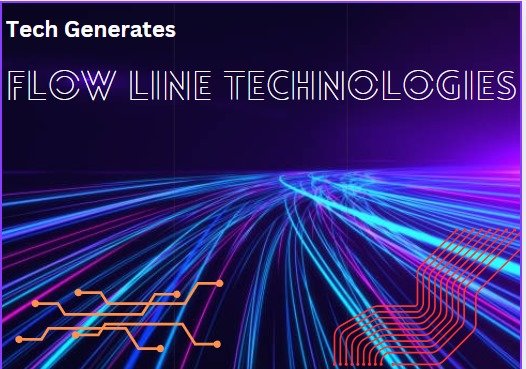Yet with rapid advancements in technology, many industries are experiencing paradigm shifts related to newer technologies that are enabling them cope with the changing face of the world. Some of the most diversified technologies are flow line systems, free flow systems, and fly wing technology. While these innovations vary in their application, they all serve the goal of making systems better by enabling resources to flow, be it materials in a factory, energy in a grid, or twenty tons of steel (or more) accelerating down the highway. We will give a comprehensive introduction to flow line technologies, discussing everything from applications to advantages, as well as how they’re related to other technologies, such as free flow technologies and fly wing technology.
Understanding Flow Line Technologies
This sentence might be too technical and not in the style of a person. The term is somewhat more common in manufacturing, production, and assembly process contexts, where eliminating disruptions and bottlenecks to workflow is emphasized. Flow lines all these elements are closely associated with manufacturing, but what they really ensure, in these environments, is keeping a fluid and non-stopping pace of work, so operations run in a smooth way. Understandably, flow line technologies are found everywhere, such as in assembly lines, where products or components advance from one work station to another, each station specializing in specific tasks. Automation and mechanization are an important part of these systems, enabling accurate, consistent, and rapid production with no human error. In the automotive industry, flow lines facilitate the seamless movement of individual car parts along the production line to assemble vehicles with precision and at high speed.
Key Features of Flow Line Technologies

- Continuous Movement: Flow line systems are designed to ensure that materials or products move continuously, avoiding stoppages and delays.
- Automation: Automation plays a crucial role in flow lines, as machines perform tasks that would otherwise require manual labor, increasing speed and consistency.
- Standardization: Each station in a flow line performs a specific task, leading to standardized output, which is essential for mass production.
- Efficiency: By minimizing downtime and improving coordination, flow line technologies optimize production times, reduce waste, and lower costs.
Applications of Flow Line Technologies
- Automotive Manufacturing: One of the most well-known examples of flow line technologies is the automobile industry. In car production, flow lines enable the rapid assembly of vehicles by moving parts through various workstations—each station adding or assembling components. This system, pioneered by Henry Ford, has revolutionized the manufacturing sector and is still in use today with significant advancements in automation.
- Food Production: Flow line systems are also implemented in the food industry for consistency and cleanliness purposes. Flow lines ensure foodstuffs efficient handling from packaging to sorting, thus maintaining quality control all throughout.
- Electronics Assembly: Flow line technologies are used in the assembly of electronics products, such as smartphones, computers, and televisions. Automated lines make certain that every single part, from circuit boards to screens, is assembled exactly and at scale.
- Pharmaceuticals: In the pharmaceutical industry, flowlines can be used to improve processes like bottle filling, label application, and package assembly. These automated systems ensure that drugs are manufactured in a sterile environment and that the production rate is tuned to demand for each product.
Benefits of Flow Line Technologies
- Speed and Efficiency: Flow line technologies increase the production speed exponentially, enabling companies to respond to high-volume orders while maintaining high standards.
- Cost Reduction: These companies are saving labor costs through automation of many of the processes which leads to reducing human error and material waste.
- Consistency and Quality: Automated quality control systems guarantee that every product passes through the same quality standards, limiting variability and enhancing quality.
- Scalability: Because flow line systems can be modified to increase production or decrease production, they are highly flexible and adaptable based on demand.
Integrating Free Flow Technologies

Flow line technologies often deal with the linear and continuous movement of materials in a controlled environment while free flow technologies are solutions that help broader systems where uninterrupted movement is essential. Management technologies become especially crucial in fields that handle real-time traffic, logistics, or energy flows where the purpose of the technology is to remove congestion and bottleneck from the system and allow them to run more smoothly.
Free Flow in Transportation
One of the most significant applications of free flow technologies is in transportation, where systems are designed to optimize the flow of vehicles, reducing delays and congestion. Free flow technologies enable smooth traffic patterns, making travel more efficient and reducing the environmental impact of idling vehicles.
- Electronic Toll Collection (ETC): One of the main causes of road congestion are traditional toll booths, which force drivers to stop and pay. Some technologies, such as electronic tolling systems, allow vehicles to pass tolls at full speed. Using RFID technology or license plate recognition, drivers can be charged automatically without having to stop.
- Smart Traffic Management: Existing traffic lights and signals can now be regulated by free flow technologies that utilize real time data from devices and cameras to modify timings depending on the existing traffic situation. This alleviates congestion and facilitates the flow of traffic through urban areas.
- Autonomous Vehicles: The effectiveness of free flow systems will greatly increase as autonomous vehicle technology matures. These vehicles communicate with one another and with traffic infrastructure, coordinating their movement and optimizing traffic flow.
Free Flow in Energy Systems
Free flow technologies are also being incorporated into energy grids to facilitate the efficient distribution of electricity. The smart grid is an electricity supply network that uses digital communications technology to detect faults, changes, or disturbances in real-time and automatically adjusts to changes and delivers the power promptly without delay or loss to where it is required.
- Smart Grids: These grids rely on data feedback through sensors and automated systems that fine-tune the flow of electricity, keeping demand in check. By leveraging technologies that enable smart grids to manage the flow of renewable energy sources, such as solar and wind, to an electrical network, which tend to produce power on-demand at irregular intervals, smart grids can manage the dispatch and use of energy on a real-time basis.
- Energy Storage Systems: In combination with smart grids, free flow technologies also facilitate the storage and distribution of energy. These systems allow surplus energy to be stored and released when needed, helping to balance supply and demand in real time.
Benefits of Free Flow Technologies
- Reduced Congestion: In transportation, these technologies help ease traffic, ensuring faster commutes and less environmental pollution.
- Cost Savings: By optimizing the flow of energy or traffic, free flow systems can reduce costs associated with energy waste, fuel consumption, and delays.
- Increased Reliability: Free flow systems improve the overall reliability of services, whether it’s reducing blackouts in power grids or preventing traffic accidents caused by congestion.
- Environmental Sustainability: In energy systems, free flow technologies enable more efficient use of renewable energy, contributing to a greener, more sustainable future.
Fly Wing Technology: A Breakthrough in Aerospace Design
While flow line technologies and free flow technologies are primarily concerned with manufacturing and system efficiency, fly wing technology is an innovative advancement in the field of aerospace engineering. Inspired by nature, particularly the wings of birds and insects, fly wing technology aims to develop more adaptable and efficient wings for aircraft, improving aerodynamics, fuel efficiency, and overall flight performance.
Fly wing technology is characterized by flexible, shape-shifting wings that adjust to different flight conditions, reducing drag and enhancing lift. This dynamic capability is a significant departure from traditional fixed-wing designs, which have limited ability to adapt to changing flight environments.
Applications of Fly Wing Technology
- Fuel Efficiency: Fly wing technology can help aircraft use fuel more effectively decreasing drag and increasing lift leading to lower operating costs and less environmental impact.
- Improved Maneuverability: Shape-shifting wings on aircraft can help them perform better during tricky flight conditions, such as high-speed maneuvers and turbulence, allowing for improved safety and comfort.
- Environmental Impact: Leveraging aerodynamics like never before to create a large-scale wing profile, fly-by wing technology creates a significantly reduced carbon footprint, resulting in more environmentally friendly flights.
The Intersection of Technologies
Though flow line technologies, free flow technologies, and fly wing technology are different in their specific applications, they share a common focus on improving efficiency and optimizing the movement of resources. In manufacturing, flow lines enhance the speed and precision of production processes; free flow technologies improve the distribution of traffic and energy; and fly wing technology revolutionizes the way aircraft interact with the air to optimize flight.
Each of these technologies relies on advanced automation, real-time data analysis, and adaptability to improve systems and make them more efficient. Whether it’s the continuous motion of materials in manufacturing or the dynamic capabilities of an aircraft wing, the goal is the same: to create systems that work seamlessly and effectively, driving progress in their respective industries.
Conclusion
Flow line technologies, free flow technologies, and fly wing technology are prime examples of how innovation is transforming industries across the globe. Increasing the movement of materials, vehicles, energy and even aircraft these technologies are impacting efficiency, driving down costs and reducing environmental impact. As more and more industries suit up for automation, adaptability, and real data, the adoption, and amalgamation of these two will increase, creating advanced and cohesive systems that will benefit both businesses and humanity.



